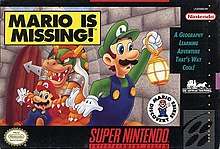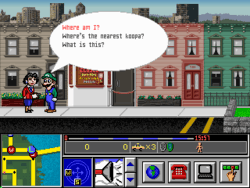Mario Is Missing!
| Mario is Missing! | |
|---|---|
 North American cover art (SNES version) | |
| Developer(s) |
The Software Toolworks Radical Entertainment (NES version) |
| Publisher(s) |
The Software Toolworks (North America) Mindscape (PAL region) |
| Composer(s) |
Rob Wallace Sam Powell (PC) |
| Series | Mario |
| Platform(s) |
MS-DOS Nintendo Entertainment System Super Nintendo Entertainment System Macintosh |
| Release |
MS-DOS
|
| Genre(s) | Educational game |
| Mode(s) | Single-player |
Mario is Missing! is a 1993 educational video game developed and published by The Software Toolworks for MS-DOS, the Nintendo Entertainment System (NES), and the Super Nintendo Entertainment System (SNES). A Macintosh version was released in 1994. The player controls Luigi, who must travel around the world to find and return stolen treasures as part of a quest to find his brother, Mario, who has been captured by Bowser. Mario is Missing!, part of a series of educational Mario games, marked Luigi's first starring role in a video game, which would not occur again until 2001, when Luigi's Mansion was released on the Nintendo GameCube.
Gameplay

Mario is Missing! is an educational game. The computer version is a point-and-click adventure game, while the NES and SNES versions have more of an emphasis on platforming.[1] In the game, Bowser, king of the Koopas, has relocated from the Mushroom Kingdom to the real world, where he has set up his headquarters in an Antarctican castle.[2][1] Bowser plans to steal the Earth's treasures with the use of the Passcode-Operated Remote Transportation and Larceny System (PORTALS), which allows his Koopas to teleport anywhere in the world.[2] Bowser plans to sell the treasures to pay for enough hairdryers so he can melt the ice of Antarctica.[3][4] Bowser captures Mario to prevent him from foiling the plan, and it is up to Mario's brother Luigi to save him.[2]
The player controls Luigi throughout the game. At the beginning of the game, Luigi and dinosaur Yoshi are at Bowser's castle, and Luigi has access to the PORTALS, allowing him to teleport to cities where the Koopas are operating.[2][5] The player can view a map of the city that Luigi is currently in, as well as a map of the world that is known as the Globulator.[6][2] The player can use the Globulator to control Yoshi's movements across the world, which is necessary to reunite Yoshi with Luigi.[2] The player also has access to a computer that keeps track of various clues learned throughout the game.[2][6][1]
Notable locations in the game include Cairo, New York City, Paris, and Tokyo. Missing artifacts include Big Ben, the Mona Lisa, and the Great Sphinx of Giza.[2] Upon arriving in each city, the player must figure out what city Luigi is in and then determine what artifact has been stolen and where it can be found; to figure these out, the player must talk to local people and ask them questions. Each city contains multiple tourist information centers, as well as three stolen treasures, which are obtained by dispatching the Koopa who is carrying each one.[2][1] The treasure then must be taken to the correct tourist information center, where a woman then asks the player general questions about the city.[2][7] When the artifact is restored, a picture is taken of Luigi with the artifact and is then placed into a photo album.[6][7] The player then must summon Yoshi to Luigi's current location so the dinosaur can eat a Pokey that is blocking the level exit leading back to Bowser's castle.[2][8][1]
Development and release
To capitalize on educational games, which were popular at the time, Nintendo partnered with Radical Entertainment to create an educational Mario game.[1][9] Nintendo licensed the Mario characters but was otherwise not involved in the game's development,[8] nor was Mario creator Shigeru Miyamoto.[1] The Software Toolworks released the game for MS-DOS in January 1993.[10][11] Mario is Missing! marked Luigi's first starring role in a video game, followed by Luigi's Mansion (2001) and Luigi's Mansion: Dark Moon (2013).[12]
Nintendo later re-released the game for their own video game consoles.[9] In the United States, The Software Toolworks had released the NES and SNES versions by June 1993.[13][5][6] By October 1993, Mindscape had published NES and SNES versions in Europe.[2][14] The SNES version used audio and visual assets from Super Mario World while the NES and SNES versions use the same Mario, Luigi and Yoshi sprites from Super Mario World.[1] The DOS version uses stretched-out character animations, unlike the later versions.[1]
In the United States, The Software Toolworks released a Macintosh version on CD-ROM and floppy disks in June 1994, under the title Mario is Missing! CD-Rom Deluxe. The new version included 127 QuickTime clips featuring 99 landmarks, including the Golden Gate Bridge and the Great Wall of China.[15]
Reception
| Reception | ||||||||||||||||||
|---|---|---|---|---|---|---|---|---|---|---|---|---|---|---|---|---|---|---|
| ||||||||||||||||||
Due to the educational, rather than action/adventure content gamers of the time were used to, reception of the title was initially mixed. However, sales of the NES and SNES versions exceeded $7 million in profit for Software Toolworks during the second quarter of 1993.[13]
Electronic Gaming Monthly reviewed the SNES version; three of the magazine's four reviewers commented that the game is too slow and easy for experienced gamers, but that it offers great appeal to its young target audience while providing good educational value.[18] Reviewers for GameFan praised the game's SNES version and compared it to Carmen Sandiego.[5] Nintendo Power noted the game's "excellent" graphics.[6] GamePro, reviewing the SNES version, called the game "a good way to learn geography," but wrote that players should not expect the game to be exciting. The magazine also noted that younger players would need help in progressing through the game.[20]
Nintendo Magazine System UK reviewed the SNES version and wrote that it succeeded as both an educational and entertaining game, but noted that it would only be suitable for people of a certain age.[19] SNES Force criticized the graphics and the restricted gameplay, and noted that it was too easy for older players and too difficult for younger players.[2] Total! wrote that the NES version was not as good as the SNES version, stating that it was missing "a bit of the graphical humour – but it packs in almost as much game-play and educational value."[14]
Chris Cavanaugh of AllGame reviewed the SNES version and considered it to be "somewhat enjoyable" for children, but believed that adult players would not be interested. Cavanaugh noted the colorful graphics, but criticized the repetitive gameplay and the "virtually identical" appearances of each city.[17] AllGame's Skyler Miller reviewed the NES version and noted that the graphics were washed-out and lacking in detail, but stated that the overall game was "as good as can be expected" for an NES Mario game that was not created by Nintendo. Miller noted that the game should appeal to younger players because of its "relatively seamless" combination of instruction and action.[16] Lisa Karen Savignano of AllGame reviewed the Macintosh version and considered it to be an enjoyable game with adequate graphics, but also stated that it was a simple game, noting that it was intended for young players. Savignano called the music "quite nice" but noted the basic sound effects and the lack of voiceovers.[7]
Luke Plunkett of Kotaku wrote in 2012 that unlike the NES and SNES versions, the PC version "was the star, featuring not only more content but better visuals as well," although he also noted that the game was "awful" and not very educational.[3] Kevin Wong of Kotaku noted in 2015 that the game was poorly received in many online reviews, although Wong himself praised the character animations and music, and wrote, "I think the backlash against Mario is Missing comes down to measured expectations; what is suitable or primally engaging at a young age could be dull and tedious at another."[21]
In 2016, Samuel Roberts of PC Gamer noted that the computer version had poor pixel art and that "every street has the exact same buildings on it, and all the NPCs are exactly the same no matter where I go." Roberts also wrote that the game was "conceptually baffling and hated by Nintendo fans."[8] In 2017, Seth Macy of IGN included the game on a list of the "Weirdest Mario Games Ever Made," writing that the game's weirdest aspect "is how Bowser weaponizes climate change to melt the ice of Antarctica, flooding the Earth so he can steal landmarks. It's a super villainous plot and would cause the deaths of billions."[4]
See also
References
- 1 2 3 4 5 6 7 8 9 Buchanan, Levi (August 7, 2008). "The Other Mario Games, Vol. 2: Mario is Missing. And many gamers left him that way". IGN. Retrieved January 17, 2018.
- 1 2 3 4 5 6 7 8 9 10 11 12 13 14 "Mario is Missing review (SNES)". SNES Force. September 1993. pp. 58–59. Retrieved January 17, 2018.
- 1 2 Plunkett, Luke (June 28, 2012). "The Mario Games That Were, For Some Reason, Released on PC". Kotaku. Retrieved January 17, 2018.
- 1 2 Macy, Seth (November 14, 2017). "Weirdest Mario Games Ever Made: From diffusing bombs in the jungle to educational time-travel, Nintendo's mascot has lived a strange life". IGN. Retrieved January 17, 2018.
- 1 2 3 4 "Viewpoint". GameFan. June 1993. pp. 18, 66. Retrieved January 17, 2018.
- 1 2 3 4 5 "Mario is Missing!". Nintendo Power. July 1993. pp. 26–27. Retrieved January 17, 2018.
- 1 2 3 4 Savignano, Lisa Karen. "Mario is Missing! – Review (Macintosh)". AllGame. Archived from the original on November 15, 2014.
- 1 2 3 Roberts, Samuel (May 5, 2016). "The PC Mario game that time forgot". PC Gamer. Retrieved January 17, 2018.
- 1 2 Ingenito, Vince (September 9, 2016). "8 Mario Games Released On Non-Nintendo Platforms". IGN. Retrieved January 17, 2018.
- ↑ "Consumer electronics firms hope recession is over". United Press International. January 6, 1993. Retrieved January 17, 2018.
- 1 2 "Computer Games 'Mario is Missing' finds educational niche". Boston Herald. January 3, 1993. Retrieved January 17, 2018 – via NewsLibrary. (Subscription required (help)).
- ↑ Franich, Darren (June 8, 2011). "Luigi's Mansion Super Mario". Entertainment Weekly. Retrieved January 17, 2018.
In his first starring role, Mario is Missing, Luigi putzed around the world learning several valuable lessons about globalization. In Luigi's Mansion, Mario went missing again, and Luigi had to fight ghosts with… a vacuum cleaner.
- 1 2 "Software Toolworks Reports 41-Percent Gain in Revenues for the June Quarter; Quarterly Loss Narrows to −2 Cents Per Share". The Free Library. August 4, 1993. Retrieved January 17, 2018.
- 1 2 3 "Mario is Missing review (NES)". Total!. October 1993.
- ↑ "The Software Toolworks Ships Mario is Missing! on Macintosh CD". The Free Library. June 23, 1994. Retrieved January 17, 2018.
- 1 2 Miller, Skyler. "Mario is Missing! – Review (NES)". AllGame. Archived from the original on November 15, 2014.
- 1 2 Cavanaugh, Chris. "Mario is Missing! – Review (SNES)". AllGame. Archived from the original on November 14, 2014.
- 1 2 "Review Crew: Mario is Missing". Electronic Gaming Monthly. EGM Media, LLC (47): 28. June 1993.
- 1 2 "Mario is Missing review (SNES)". Nintendo Magazine System UK. 1993.
- ↑ "Mario is Missing review (SNES)". GamePro. October 1993.
- ↑ Wong, Kevin (August 15, 2015). "Actually, Mario is Missing Was Awesome". Kotaku. Retrieved January 17, 2018.
